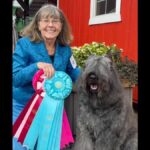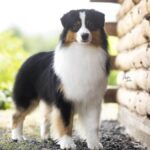This article was originally published in Showsight Magazine, December 2017 issue.
Judging for Yourself
One of the first things a judge looks at when the dogs enter a ring is the overall shape and silhouette of the animals. That initial impression is a very important one and often colors the way a judge will later perceive the dog in the hands-on portion of his/her examination. The Beardie possesses a unique outline, one that should immediately impress judge and spectator alike with its unmistakable shape. Too often we lose sense of the overall, and get bogged down in the specifics… how is the head? What about the shoulders? The loin? The tail? Even, how is it groomed? What color is it? It is the sum of all these points, after all, which defines the breed; taken singly they are essentially out of context. And yet, judge and spectator alike seem to have more problems visualizing the whole than the parts.
Here I have caricatured eight Beardie outlines. I have omitted markings, colour, eyes, and most other details in order to present a less confusing task. I have exaggerated some aspects for clarity’s sake. Assume that the dogs are in essentially the same condition, are groomed and presented comparatively alike. Assume they are all well within the standard as far as size goes and approximately the same age. These are all distractions which we can arbitrarily do away with graphically, but don’t get bogged down in problems inherent in drawings… this is a learning tool.
This, then, is your Open Dog class. They come in and go around the ring (a nice, large, flat one) and stand, as a class, for your examination. You are doing your first overview. Look carefully at each, concentrating on the shape and overall structure. What does it tell you? How do you place them? You be the judge. And remember, a judge should judge each dog against the standard, not against the other dogs in the ring.
First Place
If you picked Beardie E, you and I are in agreement. However, if you picked Beardie C, you have a very good case, too. Beardie E wins in my mind on three points over C: length and straightness of back, balance, and head. E’s body is longer than it is high, in the approximate five to four ratio. His back is level and blends smoothly into the curve of the rump. The tail is set low. The shoulders are well laid-back at an approximate 45 degree angle. The neck is in proportion to the length of the body, strong and slightly arched, and blends smoothly into the shoulders. The hind legs have well-bent stifles, the hocks are low, but not excessively so. They are perpendicular to the ground and the hind feet fall just behind a perpendicular line from the point of buttocks. The head is in proportion to the size of the dog. The skull is flat; the stop is moderate, but clearly discernible. The muzzle is strong and full and the fore face is equal in length to the distance between the stop and occiput. These are all things we can see in the drawing, and they are all things, which are called for in the Beardie standard. This Beardie should be able to move freely, supplely and powerfully. His balance should combine good reach in forequarters with strong drive behind. He should appear to glide effortlessly on the move.
Second Place
Beardie C. As they say in England, this dog was “unlucky to meet number I” today. Another nice, long dog, especially nice in the well–arched neck and the proper tail set. There is a slight rise over the point of the croup, however, keeping the topline from being completely level. Moreover, C appears to be slightly straighter both front and rear than E… that is, less angulated, especially in front. The position of the front legs is slightly less under the dog. This could also be caused by poor handling technique, but since we agreed that all our dogs were handled the same we must conclude here that Beardie C’s shoulders are not as well laid back or that the whole forequarter section is less well–constructed than E’s. Since the rear, while less angulated than E’s, is more angulated than its own front, the balance of the dog is thrown off slightly. And this will surely show up in the way the dog moves…possibly by side winding— although a dog this long may not move so badly as a shorter–backed one with the same problem. Finally, the back skull of Beardie C appears to be slightly domed or rounded, with a slope where the well–defined occiput should be. Still and all, this is a nice overall picture, of a slightly different type of Beardie than E.
Third Place
Things get a little murkier as you go down the line. My third place pick is Beardie H. While not as elegant a dog as either E or C, Beardie H has several things to recommend him…but even more to keep him out of the first two places. First, he is considerably shorter in body length, although he does appear to have a level topline. Most glaring is the high, poor tail set, which completely spoils the outline of the croup and makes him appear even shorter in back than he really is. On the move this tail will probably be carried very high, possibly beyond the vertical. His very low hocks (excessively low hocks are as improper and unuseful as high ones) are combined with a short, very angulated stifle…a combination, which often means lack of drive and extension in the rear. By contrast, his front doesn’t look too bad, but all four legs appear to be a little short even for his cobbier back. He does have a nice head and adequate neck; the neck appears to blend nicely into the shoulders. This is a finishable dog, but not a special one.
Fourth Place
Beardie F. This dog is very similar in type to Beardie H. He appears, however, to be slightly straighter in front and more angulated in the rear. Moreover, he is longer in the stifle as well. This type of unbalance results in more drive than reach and you often will see such a Beardie hackneying in his attempt to get his front out of the way of his more dynamic rear. Another high tail set, but this one looks as if it might even have been fixed. (Yes, it does happen in Beardies.) That unnatural “break” point is suspicious–looking, although it can happen congenitally as well. In any event, the set–on is too high and the carriage makes it look even worse. The head is not too bad, but if you were to take off more of that heavy head coat, you might notice that it is just a little small to be truly pleasing as far as balance goes, and that it requires a tad more stop to allow for the bright enquiring expression that is one of the hallmarks of our breed.
What About the Others?
Well…Beardie A’s steep croup, short back, and wide rear kept him out of the ribbons. His foreface is also considerably shorter than his back skull, a construction that makes the cheeks appear to be well–filled beneath the eyes, whether they are, in fact, or not; this is usually the “cutesy” type of Beardie face. His front doesn’t look too bad, but again he has “more” rear than front.
Beardie B’s topline is atrocious; the slope adds to the already short back and makes it appear even shorter. This Beardie will appear to be racing around the ring like an Irish Setter, whether he is going anywhere or not! He is short in foreface and his back skull drops off. He does not appear to have enough neck, probably because his layback is inadequate, making his front too straight.
Beardie D is short in back. Even so, his topline dips. You often find a similar dip when the dog is too long in loin and the length of back comes from there instead of the proper long, angled back ribcage. Additionally, his steep croup and/ or high tail set add to the general problem. He is tall on leg as well. The whole effect is of a square dog like an OES rather than a rectangular one like the Beardie. He is extremely straight both front and rear—especially rear— and high on hock. His foreface and back skull are the right length, but his foreface is downturned too much.
Beardie G’s head isn’t too bad, but his withers appear to be around his ears. Whether he is truly short on neck or this is another case of inadequate layback making it appear he has no neck would be determined by feel. He does seem straighter in front than in rear. He, too, is slightly high on hock. Again, a short back and rise over the point of the croup make him unlikely to move with ease or authority.
And What About That Elusive Word “Type”?
We have barely touched on the question of “type” here, for one good reason: these comments are universal and applicable to all Beardies, regardless of type. There simply is no “type” of Bearded Collie that should have a short back, or a high hock, or a domed head. Where type comes into play is when everything else is equal in quality… then, and only then, should the judge allow himself the luxury of choosing the type that he or she finds personally the most pleasing. To choose a particular type over a better– constructed and moving dog of a type that is not, say, similar to what you have in your own kennel is irresponsible judging. Breed the type you like, but look for the best overall dog in the ring when you judge.









